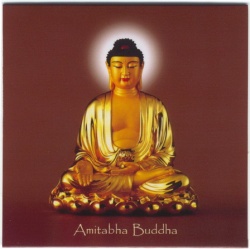Difference between revisions of "Voice the Buddhas"
(Created page with "thumb|250px| The voice (''ghosa'') is the sound made through the mouth while speaking or singing. The sound of the voice is intimately connected with one...") |
|||
| Line 1: | Line 1: | ||
[[File:Amitabha.JPG|thumb|250px|]] | [[File:Amitabha.JPG|thumb|250px|]] | ||
| − | The voice (''ghosa'') is the sound made through the mouth while speaking or singing. The sound of the voice is intimately connected with one’s physical and psychological state. Anxiety or excitement can produce a high-pitched, jabbing or rapidly fluctuating voice. Anger, fear or depression can produce a strangled, shrieking sound or alternatively a low, threatening one. The Buddha had a particularly beautiful voice which reflected his deep inner stillness and warm compassion and this must have made his talks even more convincing. It is said to have had eight characteristics; it was distinct (''vissaṭṭha'') and clear (''viññeyya''), sweet (''mañju'') and pleasant (''savanīya''), well-rounded (''bindu'') and flowing (''avisāri''), deep (''gambhīra'') and sonorous (''ninnādi''). One observer noticed that after the Buddha’s talks were over the audience would get up and leave reluctantly, keeping their eyes on him (M.II,140). | + | The {{Wiki|voice}} (''[[ghosa]]'') is the [[sound]] made through the mouth while speaking or singing. The [[sound]] of the {{Wiki|voice}} is intimately connected with one’s [[physical]] and [[psychological state]]. [[Anxiety]] or [[excitement]] can produce a high-pitched, jabbing or rapidly fluctuating {{Wiki|voice}}. [[Anger]], {{Wiki|fear}} or {{Wiki|depression}} can produce a strangled, shrieking [[sound]] or alternatively a low, threatening one. The [[Buddha]] had a particularly [[beautiful]] {{Wiki|voice}} which reflected his deep inner stillness and warm [[compassion]] and this must have made his talks even more convincing. It is said to have had eight characteristics; it was distinct (''vissaṭṭha'') and clear (''viññeyya''), [[sweet]] (''mañju'') and [[pleasant]] (''savanīya''), well-rounded (''[[bindu]]'') and flowing (''avisāri''), deep (''gambhīra'') and sonorous (''ninnādi''). One observer noticed that after the [[Buddha’s]] talks were over the audience would get up and leave reluctantly, keeping their [[eyes]] on him (M.II,140). |
{{R}} | {{R}} | ||
[http://www.buddhisma2z.com/content.php?id=448 www.buddhisma2z.com] | [http://www.buddhisma2z.com/content.php?id=448 www.buddhisma2z.com] | ||
[[Category:Buddhist Terms]] | [[Category:Buddhist Terms]] | ||
[[Category:Buddha Shakyamuni]] | [[Category:Buddha Shakyamuni]] | ||
Latest revision as of 01:49, 4 September 2013
The voice (ghosa) is the sound made through the mouth while speaking or singing. The sound of the voice is intimately connected with one’s physical and psychological state. Anxiety or excitement can produce a high-pitched, jabbing or rapidly fluctuating voice. Anger, fear or depression can produce a strangled, shrieking sound or alternatively a low, threatening one. The Buddha had a particularly beautiful voice which reflected his deep inner stillness and warm compassion and this must have made his talks even more convincing. It is said to have had eight characteristics; it was distinct (vissaṭṭha) and clear (viññeyya), sweet (mañju) and pleasant (savanīya), well-rounded (bindu) and flowing (avisāri), deep (gambhīra) and sonorous (ninnādi). One observer noticed that after the Buddha’s talks were over the audience would get up and leave reluctantly, keeping their eyes on him (M.II,140).
